* (restored)
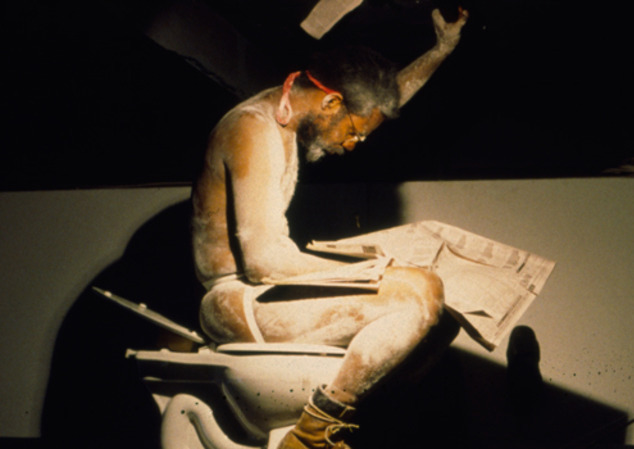
‘Living in New York in the 1970s and ‘80s involved a certain level of daily acquaintance, if not downright intimacy, with the perambulating eccentrics, avenue exhibitionists, shuffling monologists, street preachers and wandering habitués of the pavement who comprised a hefty portion of the populace. There was the wild-eyed septuagenarian who referred to himself grandly (as did everyone who crossed his path) as ‘The Mayor’, whose elaborate shtick involved roller-skating up and down Upper Broadway in gym shorts and a pinwheel hat, stopping only to enter shoe shops or delicatessens to denounce loudly any possible Trotskyites within. Notorious too was ‘Ugly George’, a once legit pornographer who ended up roaming the streets with a fake video camera and a satellite dish fashioned from tinfoil strapped to his back in search of women willing to undress for him on his late-night cable TV show of the mind. There was also the cravated gentleman who stood, rain or shine, a stone’s throw from Carnegie Hall feverishly reciting romantic arias of his own invention in frantic bouts of sweat-drenched ecstasy. Then there was the man who pushed a loudspeaker in a rhinestone-encrusted shopping trolley from his home in Harlem several miles south to Midtown on sweltering summer weekends to share the bossa nova he loved with the general citizenry. The roster of down-and-out flâneurs and blaspheming prophets goes on; the ‘floating existences’ that Baudelaire once shadowed at night.
‘It is good to keep all the unrecorded acts of personal defiance and creative survival in mind when considering the life and times of William Pope.L, who since the late 1970s has been, one way or another, giving poetic corporeal form to public invisibility and disenfranchisement, reminding us ‘of where we all come from, reinventing what is beneath us’. What lies beneath us all is the bottom line of the street, a place where Pope.L has spent much of his professional life as an artist – a 25-year span that includes performance, theatrical monologues, writings, objects and video. Not really the street-corner exhibitionist or political activist that he is sometimes taken for by the average passer-by, Pope.L might be better understood as a sort of neo-Dadaist agent provocateur shaping and magnifying the social unease of the city’s passing throng. His instrument is his body, and he is willing to use it in ways that can be uncomfortable, buffoonishly comic and traumatic – both for himself and for anyone who may happen across him. These ways, however, are always derived from the greater social absurdities and ritual indignities of the street.
‘When Pope.L set up shop as a street vendor in 1991, for example, as part of a summer-long series of street performances that he called How Much Is That Nigger in the Window – selling dollops of spoiling mayonnaise and single aspirin tablets for astronomical prices ($100 a pill) or approaching cars at intersections with the offer of free dollar bills – he was not only elaborating on David Hammons’ famous ‘blizzard sale’ of (reasonably priced) snowballs at Astor Place in 1983, but also inverting and poeticizing the economic conditions and hierarchies that already exist. It is the ubiquity of seeing the homeless peddling objects gleaned from the dumpsters and gutters of the city, or unbidden posses of ‘squeegee men’ wiping down car windscreens in hopes of a hand-out, that may explain why drivers acted put-upon by Pope.L’s attempt to redistribute a little wealth from the street up, and why no one seemed to get the punchline of his priced-to-stay-put painkillers.
‘It is his ‘crawl’ pieces – gruelling feats of physical and mental endurance in which he painfully shuffles through urban environments on hands and knees or on his stomach, boot camp-style – that epitomize how, in a city held together by the mythos of verticality and the purposeful time-is-money stride, horizontality can be an affront, an accusation, a politically precise act of stubborn abdication. As such, Pope.L’s crawler is a nightmare version of the 19th-century flâneurs described by Walter Benjamin in his Passagenwerk (The Arcades Project, 1927-40) dandies famed for promenading through Parisian shopping arcades with pet tortoises in tow, the better to aestheticize their unwillingness to conform to the quickening commercial tempo of the street. As if echoing Benjamin’s indelible image, in 1992 Pope.L was observed dragging a little white baby doll on a string around New York and Cleveland. The innocuous plastic toy, which went everywhere he went, like a dutiful puppy or an unshakeable curse, is both his helpless charge and his relentless pursuer, alter ego and millstone. He can neither hide from it nor ignore it, because it is part of him despite himself. ‘I am White Culture’, Pope.L sardonically intoned in an assumed persona in a related monologue, ‘but it’s the Negro in me that makes me what I am.’ While by his count there have been nearly 40 such street works since 1978, Pope.L only began to register in the consciousness of a broader public in the winter of 2001-2, when he embarked on the epically arduous The Great White Way: 22 miles, 5 years, 1 street (2002-ongoing), a Herculean project to crawl the length of Broadway, from the southern tip of Manhattan to its northernmost extremity. When asked why he was doing it, Pope.L answered simply ‘because it is there’. But for the extreme conditions of The Great White Way he is not outfitted as a dilettante alpinist but wearing a capeless Superman costume, as if reimagining the fantasy of the all-American superhero’s skyscraper-bounding invulnerability as a flightless act of glacially paced struggle and determination.
‘When Vito Acconci, Adrian Piper, the Guerrilla Art Action Group (GAAG) and others began synthesizing home-grown forms of Conceptual street performance and Body art in New York in the late 1960s – whether by following randomly selected strangers through the streets (Acconci) or innocuously criss-crossing Manhattan with a towel stuffed in her mouth (Piper) or splattering pig’s blood and entrails across the lobby of the Whitney Museum (GAAG), their works of unannounced provocation showed that, when it comes to catalyzing public reactions to any form of social estrangement, context is everything; add race and class to the mix, and things start to get educational. Consider two of Pope.L’s performance pieces from the 1990s: In Member (Schlong Journey) (1996) he strolled the length of Harlem’s main commercial thoroughfare, 125th Street, dressed in a talc-white suit with a long cardboard tube emanating from his crotch and a rubber surgical glove stretched over his head, the fingers of which rose and fell on the crown of his head with each breath. He looked like a deranged rooster – the original cock of the walk. In the short-lived ATM Piece (1992), which occurred in the city’s Midtown business district, Pope.L ‘chained’ himself to the door of Chase Manhattan Bank with a string of sausages, dressed in a hula skirt made of dollar bills – greenbacks that he was happily prepared to distribute to any customer entering the bank.
‘Whereas Uptown Pope.L was treated by giggling passers-by like a harmless local fool, in Midtown he was sized up as something else altogether: a thing to be avoided, a flesh-and-blood bubble of discomfort, a potential threat. In a video documenting the event, lunchtime customers can be seen first approaching, then shying skittishly away from, the entrance without breaking stride, evidently performing the instant mental calculus of risk and reward based on what they assume to be happening, and deciding that they don’t need that extra cash after all. Here, in the context of concentrated capital and power, nobody is laughing (certainly not the cops, who arrived on the scene in a matter of minutes). Such a response prompts the question of whether, if Pope.L can so easily change how he is publicly defined by simply taking a short subway ride, other signifiers of identity are equally arbitrary.
‘Pigeon-holing himself, in the catalogue to his recent mid-career retrospective Eracism (Artists Space, New York) with the tongue-in-cheek moniker of ‘Friendliest Black Artist in America©’ – a title that he has taken the time actually to copyright – Pope.L is wryly messing not only with what the established (white) contemporary art world thinks contemporary black art should be, or with what other black artists think black art should be, but with what exactly this supposedly ‘post-black’ historical moment means. For him the very idea of blackness, as nebulously defined by both black and white culture, is ‘a rabbithole’ down which, as in Alice’s Wonderland, nothing is what it superficially seems. Like the protagonist of Ralph Ellison’s classic novel Invisible Man (1952), who discovers in a flash of insight that his own otherness as an African-American has conferred on him a certain invisibility in plain sight, Pope.L has learned through the trials and errors of his own black male body that it is possible to be both painfully present and unseen. Nowhere is this clearer than in his video-documented Tompkins Square Crawl (1991), in which he laboriously dragged himself through the gutters of the East Village one steamy summer afternoon in an impeccable business suit and tie – passing skipping children and their parents, a policeman walking his beat, people parking their cars – without anyone really noticing or much caring. (Only one man seems to see him, a nearby black resident who is at first concerned for and then outraged by Pope.L, by what he takes to be a cynical mockery of the homeless and the dignity of the striving black male. ‘I wear a suit like that to work!’ he shouts down at Pope.L, close to tears, before setting off to look for a cop.)
‘No less contradicitory is Pope.L’s bafflement over white culture (which he readily admits is as much his burden and inheritance as black culture, as if either were so easily defined or extricable) or his notion of whiteness and who gets to ‘own’ it. Using white substances and objects – flour, milk, talcum powder, RediWhip, chalky laxatives (recalling the way that other Conceptual shaman Joseph Beuys once used animal fat) – Pope.L often applies these talismanic manifestations of purity and whiteness to his own body in the course of performative rituals. In Invisible Man, Ellison noted how certain African-American men about town in the 1940s would stroll through Harlem with crisply folded copies of the Wall Street Journal under their arms, not necessarily to read but to partake in its quasi-mystical aura. It is a fetish of American power that fascinates and repels Pope.L as much as it did Beuys (who used freshly delivered copies of the Journal as bedding and litter box for his wild coyote companion in the performance I Like America and America Likes Me in 1974). In Eating the Wall Street Journal (2000) Pope.L conflated the trickster figure of the coyote and the shamanistic persona of the artist by solemnly ingesting strips of the newspaper in a several-days-long ordeal of consumption and purging, performing a kind of biological alchemy while sitting high atop a throne-like toilet, his body sprinkled with refined flour.
‘Meanwhile, his expedition of one, The Great White Way, continues. Recently traversing the financial district’s ‘Canyon of Heroes’, a parade route reserved for adventurers and champions who have achieved some feat of national greatness, this prostrate, sidewalk-scaling man of steel had his ear close to the pavement. With most of Manhattan before him, the artist looked as though he were listening to and amplifying with his body the other voice of the city, the one that even its own inhabitants may not recognize as their own, a tongue in which the debased and disillusioned speak as if in a collective, somnambulist’s dream. It takes a measure of faith to keep such an act of compassion – there is no other word for it – from de-scending into one of humiliation. But faith may be, as Pope.L has said, the ‘new and ultimate material’.’ — James Trainer, Frieze
____
Further
William Pope.L @ Mitchell-Innes & Nash
The Black Factory
‘WILLIAM POPE.L DISCUSSES HIS ARTFORUM COVER AT CAA: ‘LEAVE ME OUT OF IT’’
WP.L interviewed @ Interview
‘William Pope.L Makes Statements From the Fringes’
WP.L @ Facebook
‘The Great White Way’
‘William Pope.L: The Void Show’
‘William Pope.L sets the U.S. flag waving’
‘William Pope.L wants to bring down the house’
Podcast: ‘EPISODE 405: WILLIAM POPE.L’
‘Even if You Close Your Eyes: William Pope.L’s Trinket’
‘Hole-ly Moly: The Work of William Pope.L’
‘William Pope.L—Drawing, Dreaming, Drowning’
‘Deconstructing an Artist’s Dubious Claim’
‘The Hole (Notes): William Pope.L’s Hole Theory’
‘Big Red & Shiny: WILLIAM POPE.L: CORBU POPS’
‘NEA Denies Grant For William Pope.L’
___
Extras
William Pope.L interview excerpt
Robert Wilson – Voom Portraits: William Pope.L
William Pope.L ‘Blink’
William Pope.L Artist Talk
_____
Interview
from BOMB
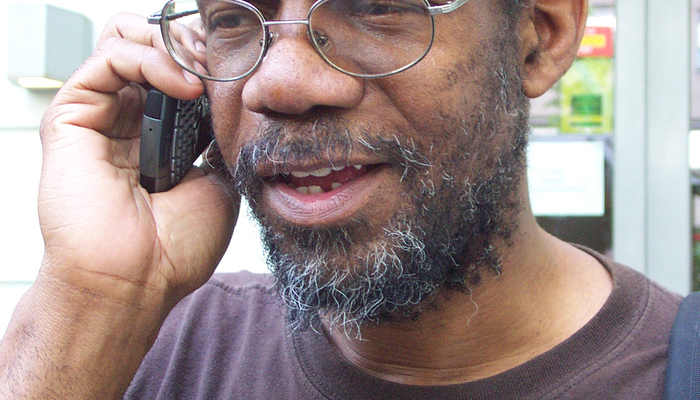
Martha Wilson All of your work is embedded in contradiction: painting, sculpture, spoken word, more full-blown performance art . . . Where did the fixation upon contradiction come from?
William Pope.L In my family, there was this tendency for things to fall apart. The conflict was in the desire to keep things together. The driving force in my work is recognizing those two tendencies and seeing them as ways to make things happen, i.e. how to produce a world or object with these types of tensions. For example, when I was young, we lived on Fifth Street, on the Lower East Side. The kitchen was yellow—a bad yellow, and old. In all the houses we ever lived in, no matter how screwed up they were, no matter how many holes in the walls, my mother always tried to make it a home. In this case, she’d discovered some old architectural plans of the building and used them as wallpaper to cover the holes. I found that very “artistic.” (laughter) Materially it didn’t solve the problem, but she always had this intelligence and this spirit about her.
MW I’m anxious to establish for the reading public why your work is embedded in contradiction, why you choose to use all the mediums that you do, and why you seem to be fixated on language.
WPL The reason for the contradiction is that I’m suspicious of things that make sense. Maybe I’m afraid of it. False security. Whereas contradiction does make sense to me. When I was able to accept that something could be true, and not true, I felt at home. This feeling felt threatening yet familiar. For example, one of the hardest paradigms is that your family can hurt you, and love you at the same time. How can that be possible? I believe if you do not accept that this can be the case, then you have to reject your family. Now, one doesn’t have to be with one’s family. But I have decided to be with them, to live my life with them. It was important for me to come to grips with the fact that I could love them and at the same time, not like them very much. This may sound simplistic, and overly autobiographical, but being able to accept that contradiction at this level has been a guiding principle for me; it’s not an answer, it’s a positioning that’s always unstable.
MW Do you end up reflecting these contradictions, or do you end up trying to overcome them, in your work?
WPL Presenting the contradiction neutrally? Without commenting on it?
MW For instance, when you were crawling in the gutter on the Bowery dressed in a suit, did you have an idea that you would change the world in any way?
WPL That’s a very funny thing to say. To change the world… I did that street work over a period of several weeks, and when I first began I believed in the image, that the conjunction of a black man and his suit, crawling down the Bowery could produce not just contradiction, but a feeling that would somehow transcend itself. My take on homelessness in New York was that we’d gotten too used to seeing these people on the streets. I hadn’t gotten used to it, but it seemed as if people were devising strategies in order not to see the homeless. We’d gotten used to people begging, and I was wondering, how can I renew this conflict? I don’t want to get used to seeing this. I wanted people to have this reminder.
MW What is the reason for the suit?
WPL Perhaps the suit is a useful cliché, but I told myself: the suit is an icon of privilege. Also, I thought: Is there a way to align myself with a people who have less than I do (materially) without making fun of them? I decided to literally put myself in the place of someone who might be homeless and on the street. I wanted to get inside that body. Like, what does it feel like? In certain yogas there are body-memory exercises. By treating your body in a certain way, by putting your body in a certain physiognomic situation, you can force it to experience in ways it normally wouldn’t. In New York, in most cities, if you can remain vertical and moving you deal with the world; this is urban power. But people who are forced to give up their verticality are prey to all kinds of dangers. But, let us imagine a person who has a job, possesses the means to remain vertical, but chooses to momentarily give up that verticality? To undergo that threat to his/her bodily/spiritual categories—that person would learn something. I did.
MW You crawled in the gutter to challenge the way black people are seen, and a black person sure enough took you at your word and almost kicked you in the face to express how upset he was with this image you had constructed. What was he seeing?
WPL He thought I was degrading the image of black people. I wanted to get up when he said that; but then at the same time I thought to myself: Well, that’s why you’re here, that’s why you’re doing this—to offer, in a sense, an alternative he maybe doesn’t want to see. It’s like Malcolm X said: “What’s a black man with a Ph.D.? A nigger.” You have a job and you’re able to put food on your table, but it’s only provisional. If you lose your job, and certain things go down certain ways, you could be on your back somewhere with your hand out looking for handouts. My family life was very uncertain. I’ll never get rid of that uncertainty. We never knew from one moment to the next when we would move, what we were going to eat . . . You grow up scared. You realize that there’s not much difference between you and street people. People think they can sustain even a lower-middle-class lifestyle, that they are entitled to at least that, but . . .
MW I think the wealthy have the same fears. They build barriers of money to prevent this. In your youth, you were a bad boy in training. You used to blow up stuff and break into things and get hauled into jails by the police. Why were you doing that?
WPL I thought it was exciting. I wanted to forget. Now I crawl to remember. But then I wanted the tension. I wanted attention . . . When you grow up in a collaborative union, like a family, it’s like a collaborative theater group, only you didn’t choose it. You’re just a bit player, the artistic directors are your parents. In my family, I didn’t feel we had much control over things. It was all crisis, and more crisis. That was the basic theme. Everything falls apart all the time. It was like a sitcom, but it wasn’t very funny.
MW But now you are contemplating a work of civil disobedience, and the fallout, as an adult, could mean that you’d be thrown in jail. It doesn’t mean what it meant as a person under 18, to be thrown in jail.
WPL No. I fear it more now. I fear losing my job because I’ll be in jail; I fear what happens when you’re in those environments—having been in a couple of them. I fear the transitions, the disruption. And cops, you know, cops and black people—even if they’re black cops. But the more I think about why I shouldn’t do it, the more I realize that I should. When I was younger and always in crisis, I was always afraid. By going out and constructing crime scenarios in the street, I could construct my fear. I could put it in a framework that made sense to me, and I could control it. I was pretty good at constructing these scenarios and getting away with it. But now, yeah, you’re right, I feel my fragility more. And it’s important for me to be socially responsible when I’m going to do an act that could be taken as socially irresponsible. I have to take responsibility for the art. I want to feel good afterwards (even if I feel bad). I need to be able to say, “Yeah, I did that because I believe in it.” And I believe in it for reasons not just about me.
___
Show
____________
Crawl (1978-1992)
‘Pope.L began a series of street performances, or crawls, in the late 1970s, in an effort to “do a work that didn’t require language, it just required an action.”
‘In 1991, wearing a business suit and holding a potted dandelion, he crawled, military-style, along the perimeter of Tompkins Square Park in Manhattan’s East Village. The park had recently been the site of riots involving the homeless population that took shelter there; squatters, activists, and the police.
‘By “giving up his verticality” during his crawls, Pope.L prompted spectators to direct their gaze downward, drawing attention to the people who exist in vulnerable positions on the street and in society. His suit underscored the deep rift between aspirations of upward mobility and the absence of opportunity that confronts many Americans.’

_____________
Reenactor (2012)
‘Reenactor is a film about how we costume and theatricalize time in order to make sense of our mortality. We dress reality up in history, documentary, biography, or art to restage and reorder the chaos of getting from one side of life to the other. Reenactor is a poor man’s parallel universe; it is my way of haunting time. I call Reenactor my Civil War film but the war I’m referring to is any great trauma that marks the land and its people such that ghosts are spawned and made restless. Most of the film was shot in the city of Nashville, Tennessee, in 2009 and 2010. Footage of historical reenactments was shot in Pennsylvania and New Jersey.’ — WP.L



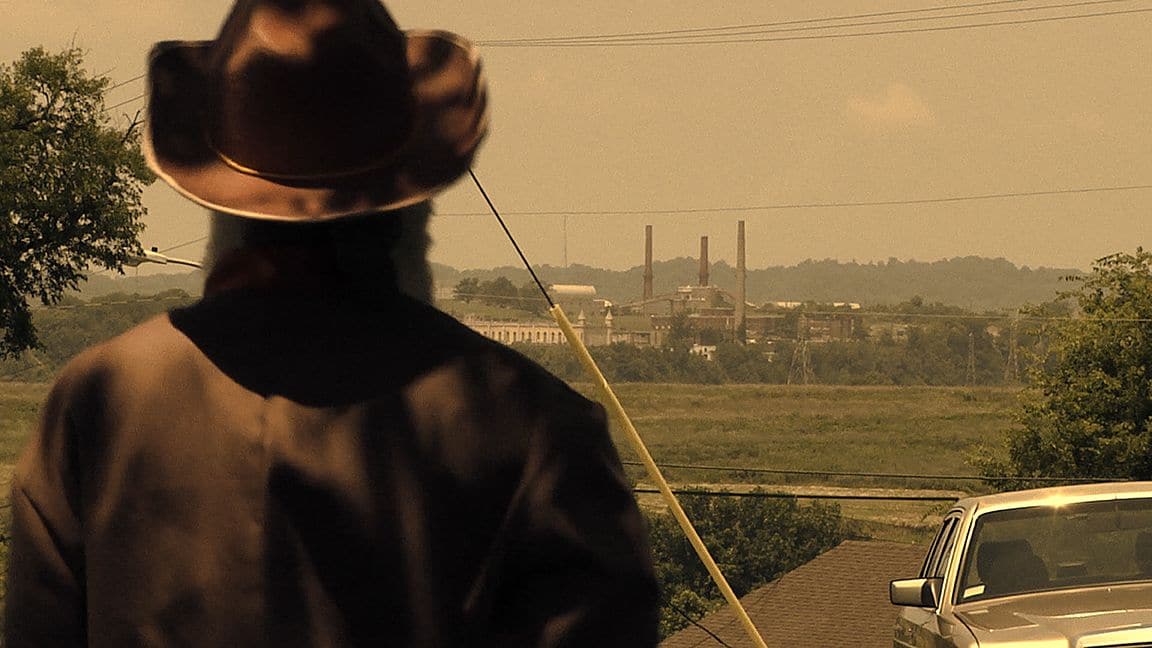
______________
White Room #4 / Wittgenstein & My Brother Frank (2004)
‘In the performance White Room #4 / Wittgenstein & My Brother Frank , Pope.L spends two hours a day, for three days, attempting to re-write from memory Wittgenstein’s ‘On Color’ and his brother Frank’s ideas on power and representation. The artist is dressed in a bright orange yeti suit while writing the text directly onto a wooden table with a microphone pen.’ — rove.tv
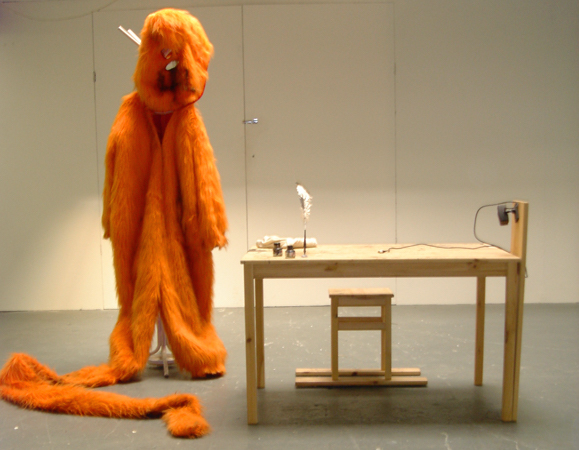
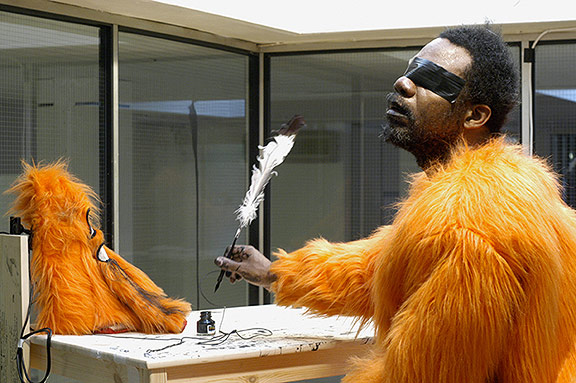
_________
Trinket (2015)
‘What is this… Trinket? Well, it is an installation that includes a flag and some fans to blow it. We are used to seeing flags. They are everywhere. Even flags as large as this one. On bank rooftops, along the highway, on construction sites. Sometimes news anchors deliver stories about protests or candidates against digital flags that seem infinitely big (a moving background conveys urgency). Occasionally, artists use the flag, too—think of Jasper Johns’s famous encaustic paintings or David Hammons’s American flag done in red, black, and green. The flag Pope.L uses is 16 by 54 feet, which is longer than a normal flag. And his flag has fifty-one stars, rather than… any of the other number that has decorated Old Glory since Betsy Ross did or did not first sew it. When I asked him about this extra star, Pope.L said it was “for you,” by which I took him to mean it was “for anybody.” A figure of surplus that is perfectly at home in America.
‘Pope.L’s flag is flown indoors, on a pole, six feet off the floor of The Geffen Contemporary at MOCA. It is strange to see a flag flown indoors, and even stranger since “flown” is not exactly right. Pope.L’s flag is ripping through the hangar-like space, stretched tight, crackling, on wind produced by four gigantic industrial fans—the kind that get used on movie sets to simulate tornadoes. These fans, called “Ritters,” have a blade diameter of six feet, and the air they move comes at speeds that can knock a person back. You don’t want to be too close to them. The vast churning of wind extends the sensory experience of the work throughout the galleries, so that it is hard not to be inside Trinket everywhere you go. The building is completely dominated by wind. There is no getting around this as a sculptural and symbolic effect.
‘All this rushing and blowing is causing the flag to fray. The stripes are separating along their seams. The flag’s original plane, massive and wall-like, becomes a hydra-head. What was once a surface dividing the room soon resembles a tangle, dodging and flicking in three-dimensional space. Now, frayed flags are also a somewhat common sight. You see them in paintings of battle scenes. You can see one out back of The Geffen, on Alameda Street, where the city has torn up a block for a new Metro stop. Flags live in the elements, after all. They get that way. But Pope.L’s fray asks to be read differently, because it is part of an artwork. It is intended. Maybe the least nettlesome of readings one could bring to it—and of course there are many—is one of time and material. Pope.L’s flag is demonstrating duration. This is what happens when X does to Y for hours, days, and weeks.’ — The Curve
____________
Vigilance a.k.a. Dust Room (2023)
‘“Vigilance a.k.a. Dust Room,” sits at the gallery’s center: A white box of two-by-fours and plywood, rigged with shop fans on timers, sounds like a choir of leaf blowers. Two small windows on one side reveal its dim interior thick with whirling foam pellets, light and dark. It’s powerful and unhinged and overbuilt — a monument to the entropy of the postindustrial city, and the tenuous dance of its inhabitants.’
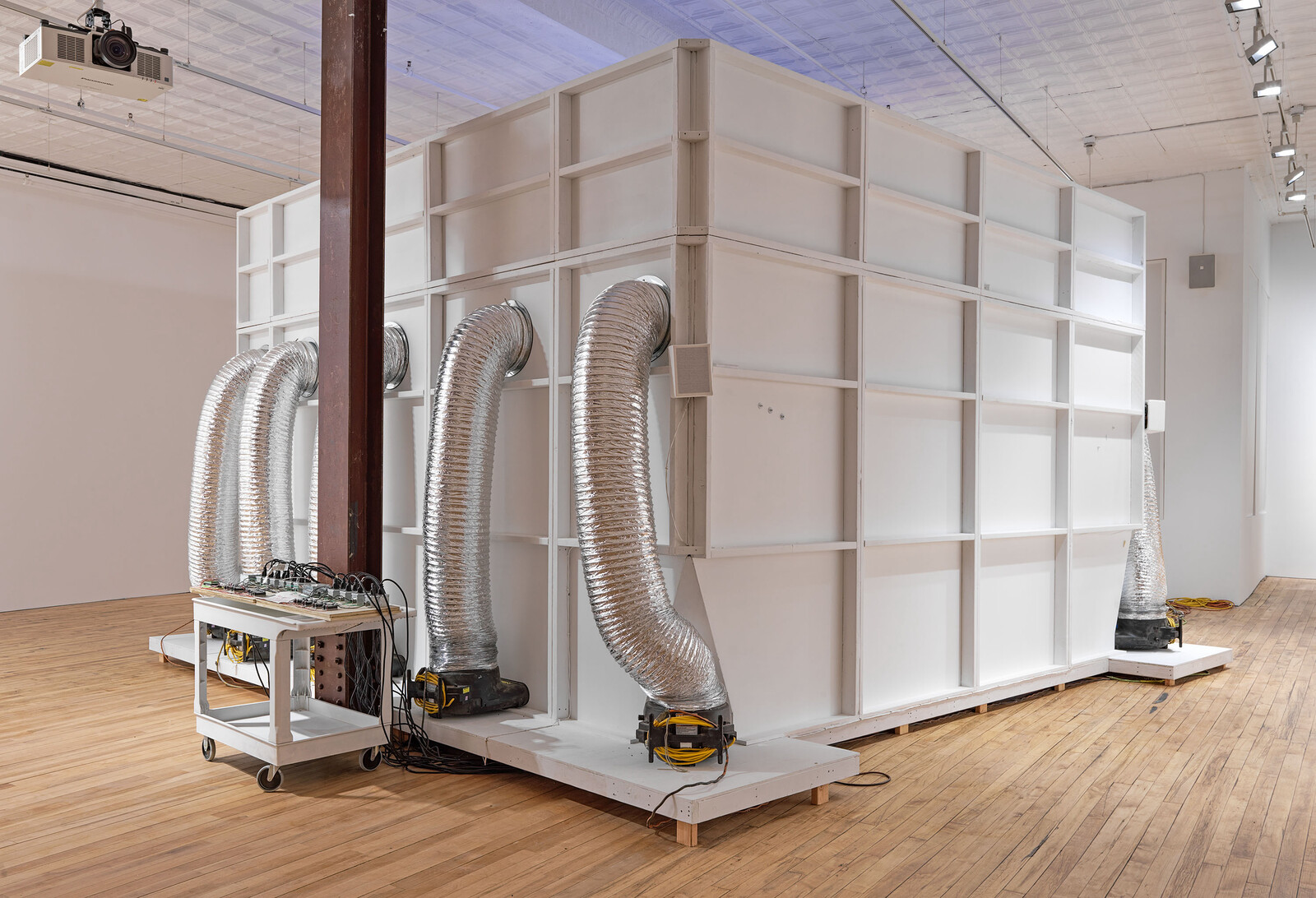
_____________
The Black Factory (2005)
‘The Black Factory, artist William Pope.L’s art performance action installation on wheels, sails off on its final voyage, traveling from Maine to the Rocky Mountains sowing provocation and discussion on race, difference and community across the heartland. It visits Newark at Washington Park on July 20, co-sponsored by Aljira, City Without Walls, and The Newark Museum.
‘The Black Factory, a mobile social service experiment, requires the participation of an audience to do its work. Typically the Factory caravan arrives at a town or roadside and sets up shop right then and there. The three person crew canvasses the neighborhood to stir up interest. Over the eight hour performance, they stop people on the street, feed them, cajole them and provoke them all in the name of forging a new dialogue about race and community in America. People respond variously. Some argue. Some sing and dance. Some walk away. Some donate their favorite black object to the factory’s archive, and some visit the factory’s gift shop and obtain a trinket whose profits support a local charity.’ — Black Contemporary Art
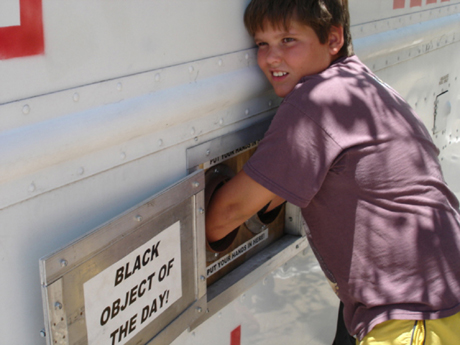
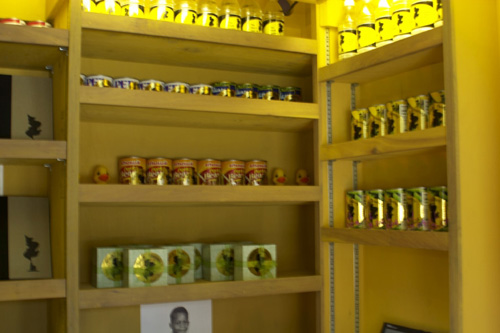

_____
Cliff (2012)
‘William Pope.L’s Cliff (2012) is a site-specific work, a drawing in vinyl. Cliff speaks in a contradictory fashion to its surroundings: its peaks and valleys are cast against the ultra-flat Midwestern urban scape that is visible through the windows in all directions. Amidst the incongruous desert cliffs one can make out single letters that spell out a slogan: ON STRIKE FOR BETTER SCHOOLS.’ — UC Chicago
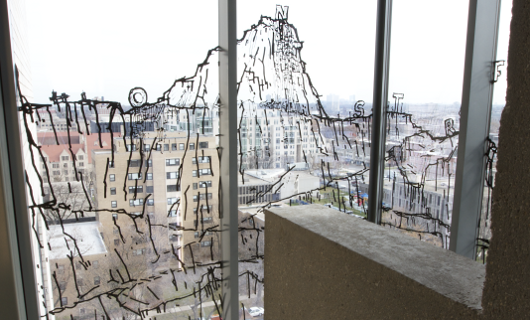
_____
Cusp (2010)
‘In the tightly scripted Cusp (2010), a succession of male art students recruited from a local MFA program entered the gallery (roughly one every hour, on Saturday afternoons only) and sat on a rudimentary bench. After retrieving a pair of extra-large pajamas from a nearby hook and pulling them over his clothing, the performer donned a Barack Obama costume head that exaggerates the President’s 100-watt smile. With the assistance of a gallery employee, the performer walked along the perimeter of a stepped platform, constructed of 2-by-4s framing a mound of dirt atop rows of bagged seeding soil, and climbed to its highest point. Extending an open hand, he accepted a coffee cup filled with a viridian green liquid, holding it not by the handle but the base.
‘For 75 minutes, the performer attempted to remain frozen, balancing the heavy cup. Inevitably, arms grew tired and palms wobbled, causing the green fluid to drip from vessel to hand to soil below. Some may have seen in Cusp a lampoon of Martin Luther King’s exalted mountaintop, with a clownlike Obama gazing out upon the so-called Promised Land. Given the current recession, others may have perceived the President clutching a measly cup of liquid soil nutrients, which he haplessly dripped upon the nation’s lifeless economic landscape. The artist would probably find such interpretations too simple and narrow.’ — Art in America
______________
Eating the Wall Street Journal (New Millennium Edition) (2010)
‘Ten performers haunt a museum, dressed in pajamas too big for them, wearing Obama masks and carrying large stacks of Wall Street Journal newspapers, they ceaselessly wander,” Pope.L explains. “Sometimes they stop and stare for long periods of time, sometimes they rip off strips of their newspapers and chew them, letting the chewed pieces fall from their mouths into the pocket of their pjs. Sometimes they end up, all ten of them, in the same room and ‘hive’. They are ghosts, always mute, exhausted but tireless. They represent the passing away of something, and the arrival of something new.’ — Greg Cook
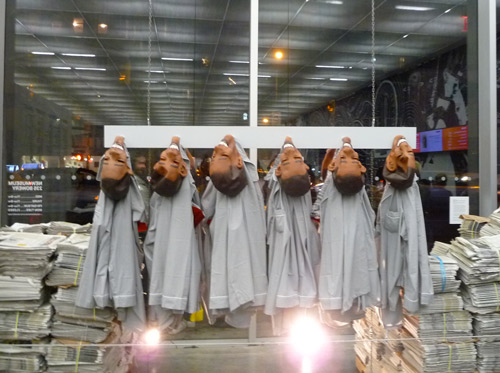

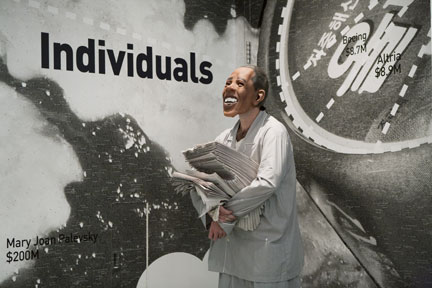
_______________
Art After White People: Time, Trees, & Celluloid … (2007)
‘Art After White People: Time, Trees, & Celluloid… was the first major West Coast museum exhibition by William Pope.L, the self-dubbed ”friendliest black artist in America,” who, throughout his thirty-year career, has challenged social inequity with dark humor and biting critique. For the Santa Monica Museum of Art, Pope.L created an installation in three parts–The Grove, APHOV (A Personal History of Videography),and The Semen Pictures–that confronted and examined ritual, human will, and political ego. Pope.L’s interest in ritual layering as an artistic process was evident; all of his ”interventions” featured objects or characters transformed by layers and veils made from such materials as paint and blood, or a simple latex mask. Art After White People brought Pope.L back to his roots in experimental theater with installations resembling stage sets.
‘The Grove was a spectral forest of potted palm trees, hand- and spray-painted in many coats of white. Close up, their painted skin appeared spotty, even wart-like–a commentary on the social, psychological, and environmental consequences of man’s will to bend nature. Pope.L chose the palm trees for this installation as ”local scenery,” and in his noir vision of Los Angeles, the city’s most prevalent icons of tropical paradise wore a toxic costume that would eventually destroy them.
‘Past The Grove, viewers saw a free-standing screening wall reminiscent of old-fashioned drive-in theaters or highway billboards. On screen, APHOV featured as its protagonist a masked man resembling former Secretary of Defense Donald Rumsfeld, weeping streams of artificial blood. The blood pooled on the floor of the man’s ”lair,” a makeshift archive piled high with cardboard storage boxes of videotapes organized by date. The rest of the on-screen clutter expanded into the real space of the museum, including furniture and the mysterious, locked industrial doors through which one could only peek at an endless warren of boxes and blood.
‘Beyond the dark and disorder of the first two works, The Semen Pictures were bathed in light. Pope.L’s final intervention consisted of digital scans of magazine collages covered with organic substances within light boxes. These ”portraits,” altered by the addition of semen, hair, milk, coffee grounds, urine, and blood, balanced readymade pop culture with the natural and handmade, and exemplified Pope.L’s artistic drive to create complex layers of image and meaning.’ — smmoa.org
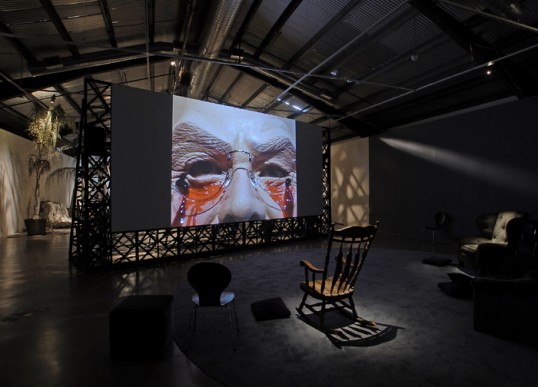
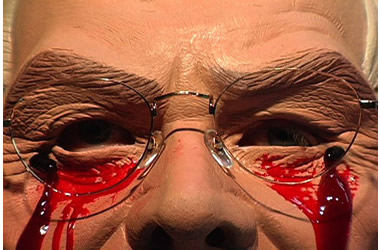
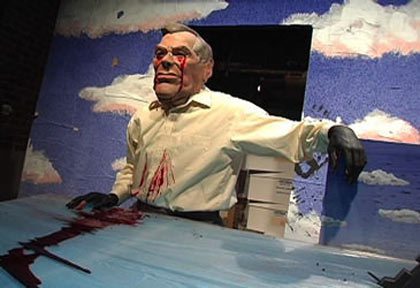
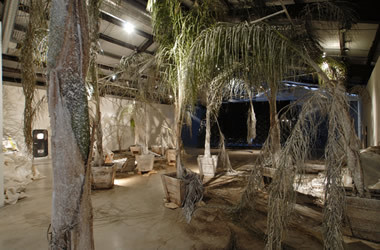
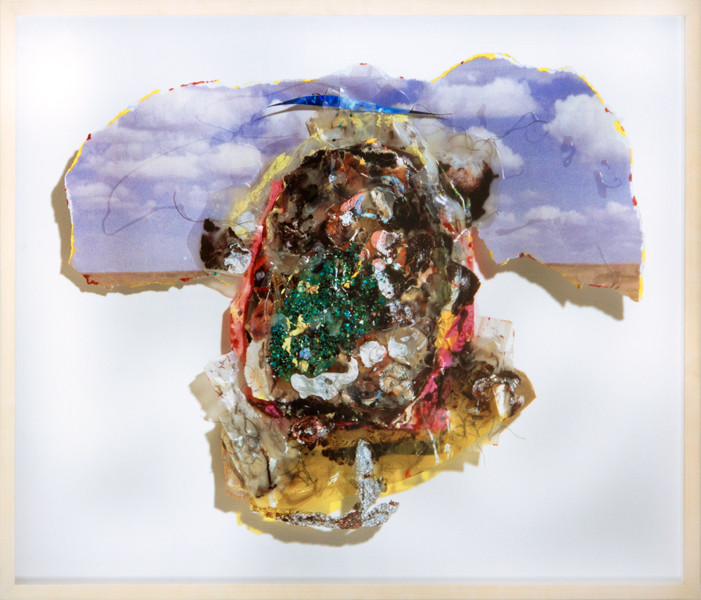
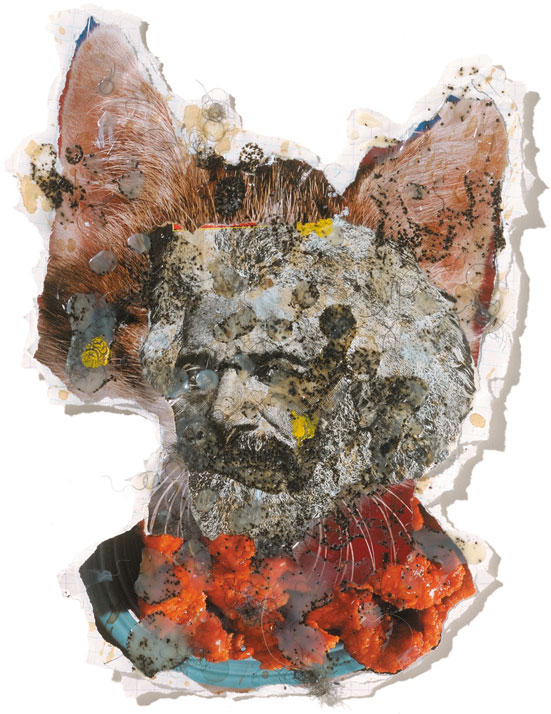
______________
Unrequited (2013; excerpt)
‘Iconic performance artist William Pope.L’s Cage Unrequited is a 25 hour marathon reading of John Cage’s edited anthology, Silence: Lectures and Writings (1961) by over eighty invited collaborators. The performance functions as a refuge, proposing a relationship between the earlier artist’s ideas of indeterminacy, mysticism and chance and the work of contemporary black artists. This is an excerpt from Pope.L’s interlude.’ — collaged
________
Small Cup (2010)
‘Small Cup–created in 2008 in an abandoned textile mill–echoes Pope.L’s broader interest in using food products to address social and political issues. In it, a group of hens and goats gradually demolish an architectural model of a neoclassical building reminiscent of the United States Capitol in Washington, D.C.’ — Marblehead
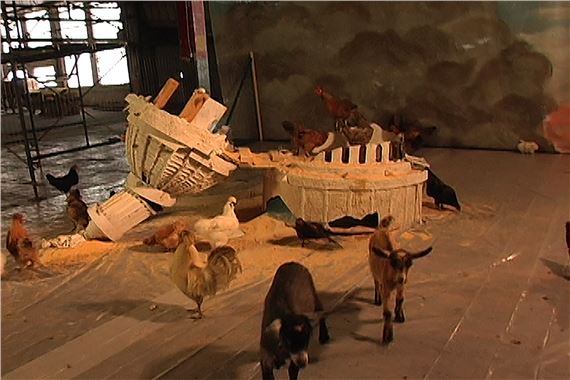
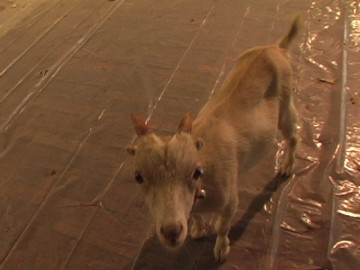
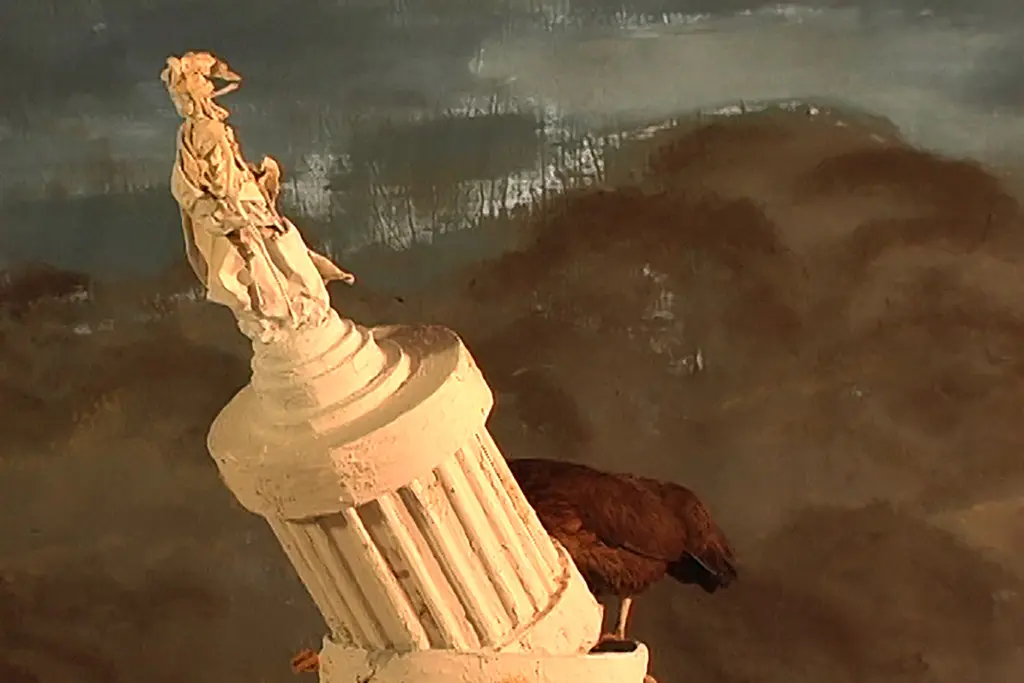
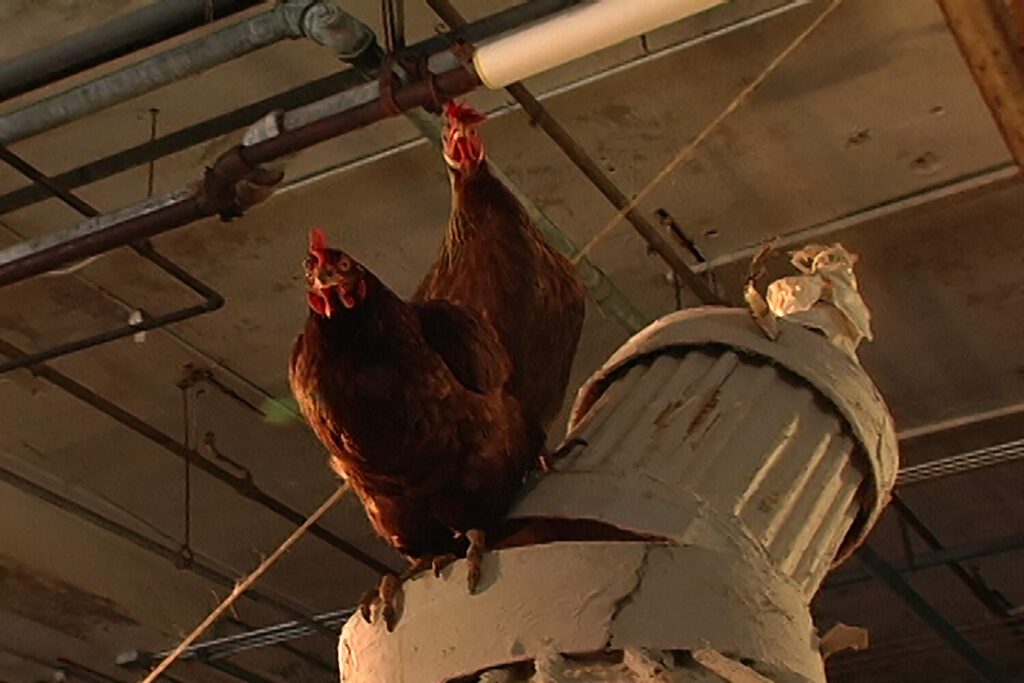
______________
Bill Cosby With Bad Attitude (2010)
Yarn, paper collage, glue, acrylic and tape
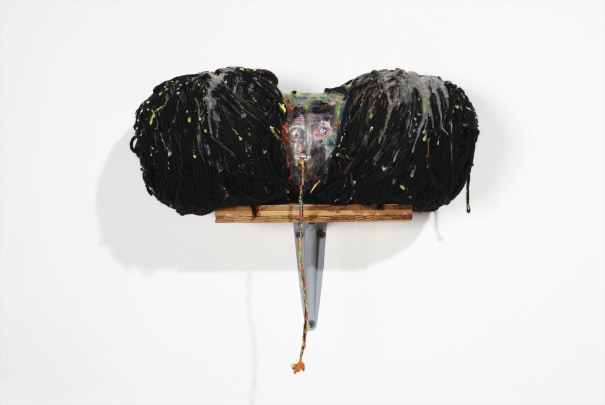
__________
Blink (2011)
‘After the devastation of Hurricane Katrina, Pope.L put on Blink (2011), a twelve-hour event involving sixty-five volunteers hauling a black ice-cream truck ten miles across New Orleans from the Lower Ninth Ward to Mid City. (It featured a rear projection screen that displayed images, sourced from local residents, that had to do with dreaming and waking up in the city.)’
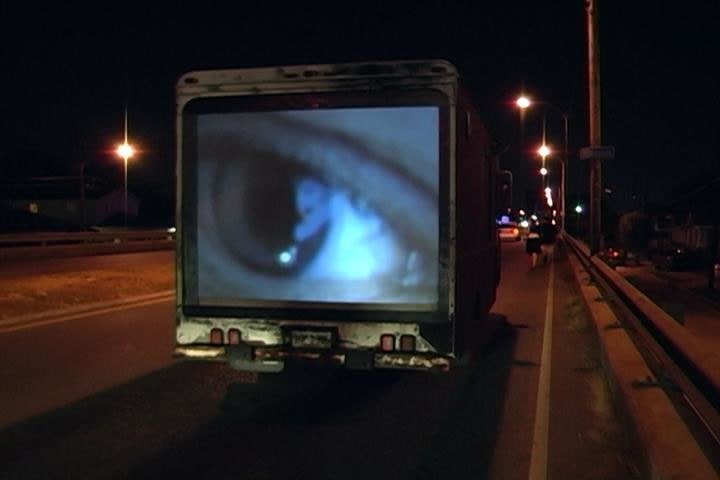
_____________
Coffin (Flag Box) (2008)
‘The sculpture, an L-shaped wooden box on stilts, has been wired for sound and emits an ominous drumming noise. The base is propped up by a copy of Philip C. Jessup’s ”Birth of Nations,” a 1974 foreign-policy treatise.’
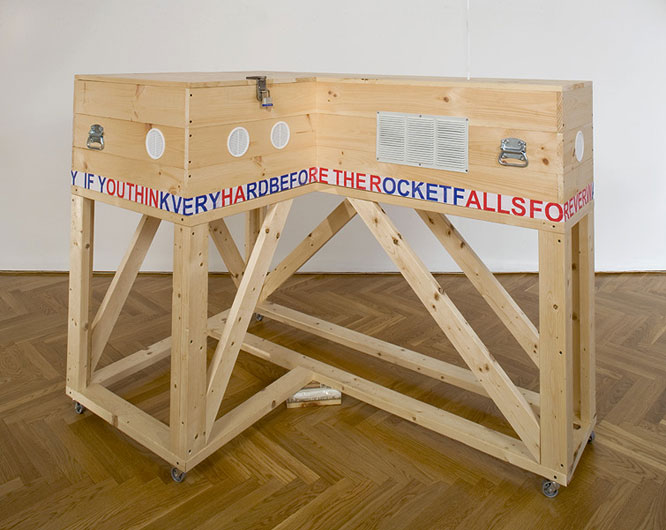
________
Burying the Blues (2013)
‘In this video, documentation of artist William Pope.L’s public program Burying the Blues is accompanied by Pope.L’s thoughts on the legacy of blues music.’ — Whitney Focus
‘Just played at the Whitney Museum (4/19) in conjunction with the Blues for Smoke exhibition on Friday. Nir Felder, Rich Robinson and I were involved in a performance piece by William Pope L entitled “Burying the Blues”. We were all dressed in white, wearing blindfolds and playing early blues and rags by Elizabeth Cotton and John Lee Hooker as a starting point for exploration of the blues.The artist proceeded to bury us by raining confetti from above, while the audience took pieces of the paper and wrote letters to dead bluesmen (envelopes and stamps provided). Certainly one of the stranger gigs I’ve been involved in.’ — Kenny Wessel
____________
from Set Drawings (2003)


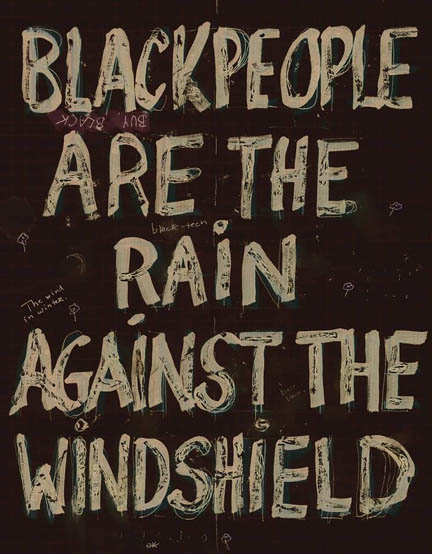
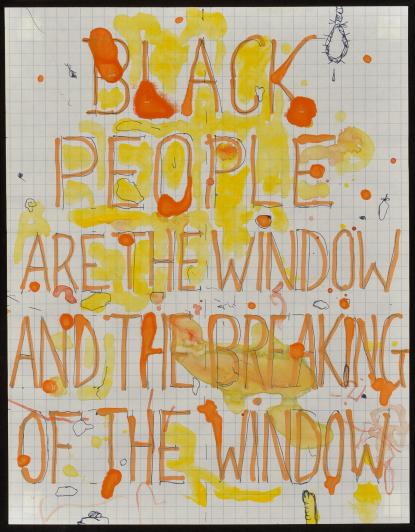
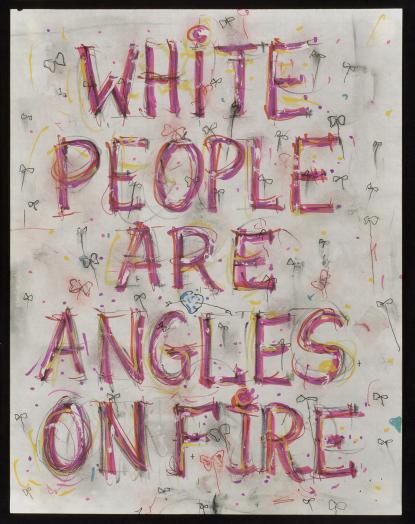
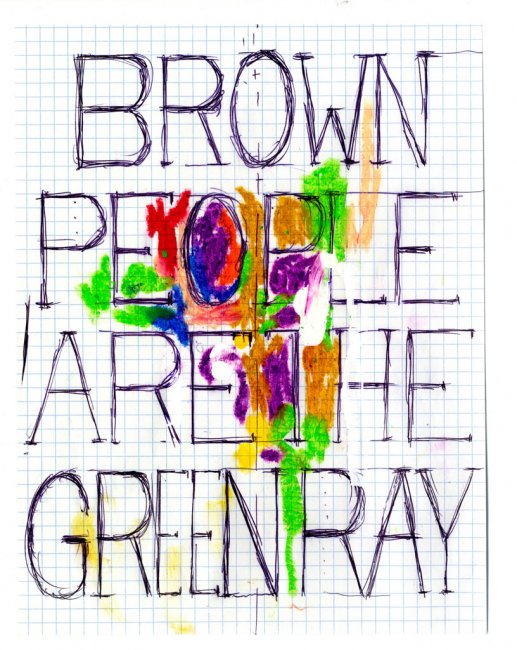
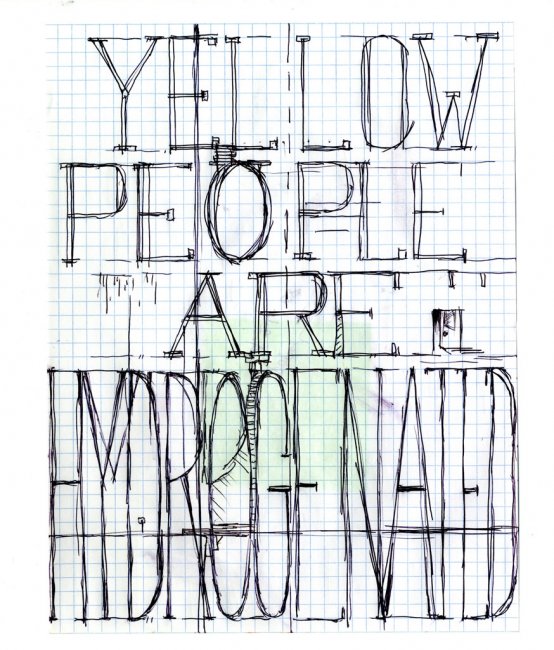

_____________
Allan Kaprow Yard (2009)
‘James Kalm climbs to the top of the pile of tires in this reinvention of Allan Kaprows Yard at the debut exhibition of Hauser & Wirth New York. William Pope. L adds his own narrative text using a Barack Obama imitator, and flashing lights in this restaging, Upstairs we tour an in depth collection of posters, prints and documentation tracing the historic arc of this Happening which was originally created in this very location in 1961.’ — jameskalm
_______
Forlesen (2013)
‘Pope.L’s latest experiment is the exhibition Forlesen. It takes its title from a sci-fi story by Gene Wolfe and is a fascinating fantasy about a place where the topic of race is more playground than provocation. Dozens of drawings are pinned on the hallways of Pope.L’s spaceship-like giant penis structure that fills much of the gallery. Viewers can roam through the long structure as manipulated tapes of bargain-bin pornography play inside. The sexual perversity is furthered in some of Pope.L’s drawings that look like they’re made with dried pools of semen and shaved body hair. (The hair is real; the semen is translucent acrylic gel.)
‘But the porn seems like a distraction from what is really on Pope.L’s mind: race, and how we perceive it. “There’s a real richness to this misreading of what is there and what we imagine or what we fear or what we want or what we don’t want,” said the artist at a recent talk held in conjunction with his new exhibition. Riffing on skin color, and the way we oversimplify skin color, Pope.L got deep about “white” people: “Well, what are they? Are they really white? They’re kinda like mysterious.”’ — Chicago Magazine
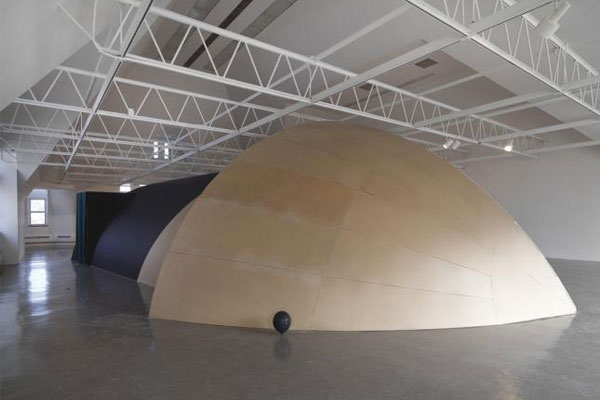
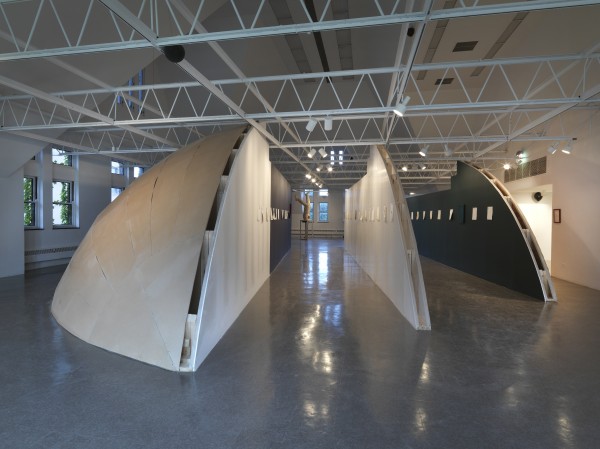
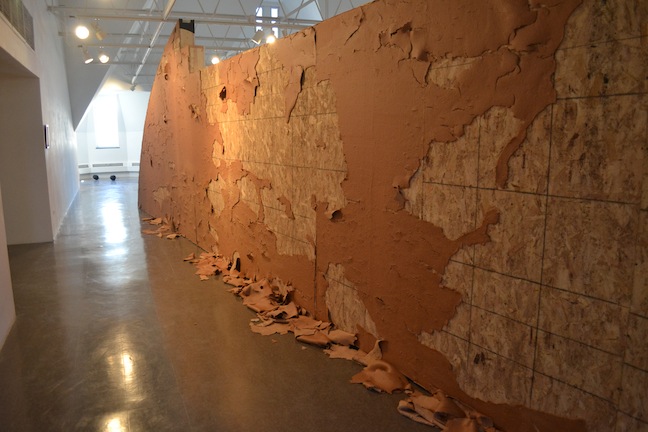
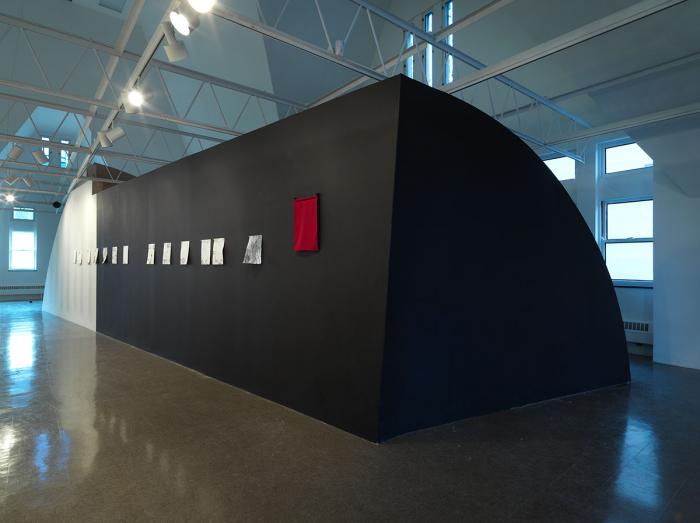
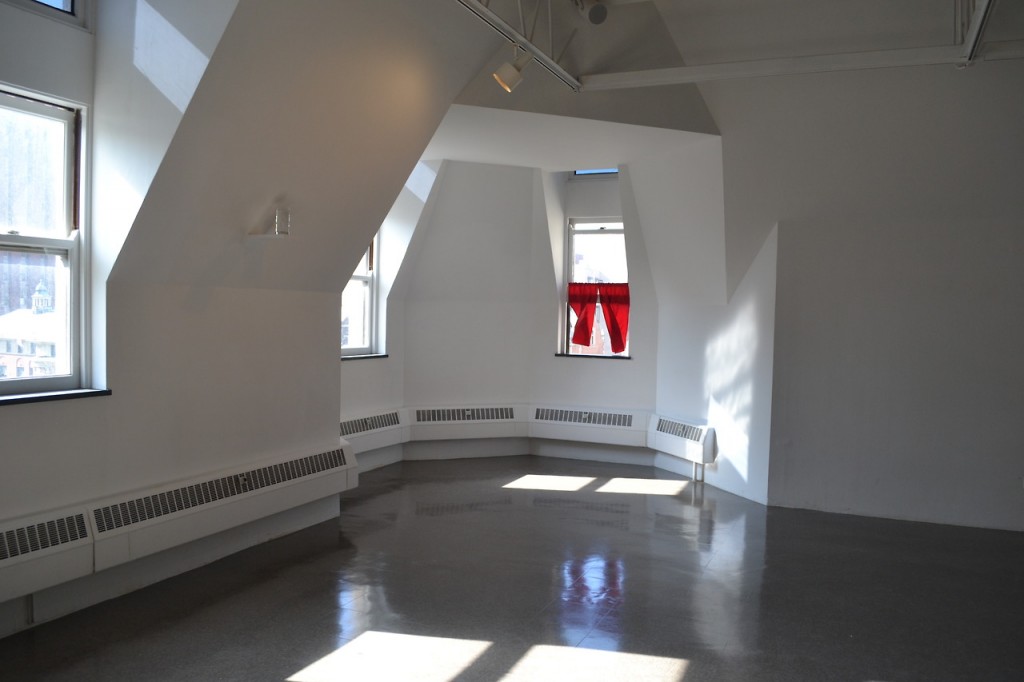
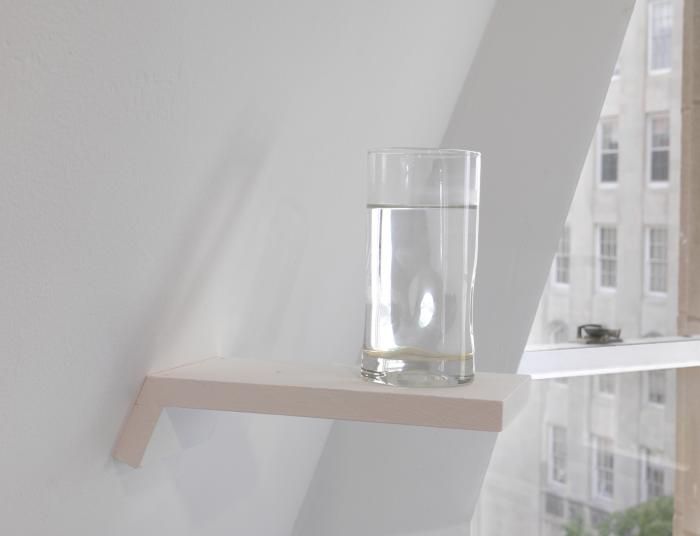
______
Pull! (2013)
‘Renowned performance artist William Pope.L has a proposition for Cleveland: can we manually pull an 8-ton truck through the city, as a testament to the power of shared labor? Pull! is a durational. city-wide community performance piece, in which hundreds of Clevelanders will manually pull a truck for 25 miles, through the neighborhoods of North Collinwood, Glenville, University Circle, Hough, AsiaTown and downtown; to West Park, Clark-Fulton and Ohio City. Images collected from people across Cleveland about what work means to them will be projected from the back of the truck as it is pulled through the city.’ — Spaces Gallery
*
p.s. Hey. ** Corey Heiferman, Hi. I would definitely need some external incentive to read ‘Frankenstein’. Maybe your prop will be the incentive. Weirder things have happened. The reading sounds cool, and congrats on the magazine acceptance. Hook us up at launch time. I want less than nothing to do with liver in any form even vegan fakery. Okay, on the picnic but I’ll be wearing a clothes pin on my nose. I didn’t know that about breakdancing at the Olympics. They should have crumping too. And bring back tug of war, of course. Oh, I don’t remember the gifts themselves. Odd things. Not, like, perfume for the nose, for instance, unless it was super rare or something. I’ll hunt my memories. ** Jack Skelley, Jacccck! We should’ve celebrated your anniversary on Saturday. Cool, been waiting for your Hitchcock spiel. Everyone, the mighty Jack Skelley has written a kind of report/review thing about a recent gig where Robyn Hitchcock played Syd Barrett songs, and it’s at LARB, and that’s here. Kraftwerk! You dog of luck! Deeeeeeennis. ** Ferdinand, Hey, Ferdinand! Good to see you, sir. Thank you for the share. I’ll have to wait I’m done here to imbibe them, but … Everyone, Ferdinand, South Africa-located artist and person of mystery, shares two new tracks uploaded this weekend under his new alias/side project tagged as “Stolen Parts TV”. He’ll introduce: ‘Im sampling guitars for the first time (what took me so long) and these drum loops sound big. Have a listen first to the b-side I made last night here. And then reverse it as one does by playing the A side like it was unintended. It is entitled ”I dont think we’re ready” and it amuses me how the sampled guitar riff sounds a bit like the Beverly hills 90210 theme from that TV show. Here.’ Hit them up, folks! Thanks, pal. ** Cletus, I am enjoying reading it very much! Big up. ** Max Restaino, Hey, Max! The book is pretty great. You’ll no doubt be very sated. Right, the horror novel, thanks for reminding me. Hm…. *imagining* ** Lucas, Hi, Lucas. ‘Jeanne Dielman’ is amazing. I wouldn’t let that ‘best’ acclimation thing dissuade you. Thrilled if I can help add another Francophile to the world and hopefully get Francophiles off the endangered species list. There used to be this great illegal site called zLibrarty where you could download pdfs of tons of great books, including Blanchot’s gratis, but it finally got killed. Huge loss. Maybe libraries have his books, worse comes to worse? My weekend … I went out on Saturday and all the streets around my apartment were blocked off, and there were police with AK47s everywhere, and then I saw why when a line of black cars drove by and Biden was sitting in the backseat of one of them. A painter came by yesterday and took bunch of photos of me for a portrait he’s going to paint of me. I had my Zoom club, and the assembled liked the assigned text (Deleuze) and disliked the assigned film (‘The Vanishing’ (1988)). And I wrote and wandered, and it was sunny. Nice photos, plane(s). There’s a law against flying over Paris, and when you see one flying over, it’s kind of spooky. Cool, thanks, I hope they’re airdropping things from the US that you can’t buy here like macaroni & cheese and NyQuil. Phantasialand! That’s my second favorite amusement park. It’s great! Beautifully themed, so many really good rides. It has my favorite roller coaster in the world: Taron. Ride it. Wow, fun, or I hope and assume it was. Tell and show me. I hope ‘River Quest’ has your name on it. ** Shirley, Hi, Shirley. Thank you. Barry Manilow? My only association with him is from the days when he was piano player for Bette Midler back in the, what, 80s? And that a friend of mine had sex with him. So, I’m kinds of fuzzy re: him. Glad he was fab! ** _Black_Acrylic, Saviour! Everyone, _Black_Ben_Acrylic_Robinson’s mega Play Therapy v2.0 podcast returns ‘and is going to make a wonderful contribution to society’. He’s right. Join its growing cult here. Can’t wait! ** Steve, I didn’t end up getting to go, but the film opens in theaters here on Wednesday. I hope that semblance plan is paying off. ** Harper, Hi. Oh, gosh, designating Rimbaud as a rival will put you on a rough road. My guess is, yes, if he’d kept writing he would probably have become a very good writer but not a mind and life changing force. He would have been one those writers where you go, ‘I know he’s boring now, but, shit, you should read his early work! You’ll be shocked!’ I have to say I’m astonished that you’re able to type and think so clearly and complexly while quitting cigarettes. Quitting turned me into a slug for six months. Keep at it if you possibly can. Quitting smoking is a huge boon. I remember what it was like. You doing the patch? My friend Zac was a heavy smoker until he quit two years ago, and he basically covered his body in patches, and it worked, although he was a little lunatical there for quite a while. Wow! Bravo! ** Justin D, My parents were quite conservative, and they were very into just fitting in and not being outrageous in every way humanly possible, so I guess that’s why? Your growing up sounds a whole lot more fun. I avoid TV series like the plague out of fear of distraction/addiction, so I’ll trust you on that show. Swervedriver are pretty cool. Kind of shoegaze meets Sonic Youth when they’re most on. I described my weekend to Lucas up above. It was alright. How was yours? ** Bill, Thanks for the info and link. Weekend? ** Logan Berry, Hi, Logan. My pleasure and honor entirely. The book’s fantastic, need I say. I hope the performances are going really well. ** Oscar 🌀, Unfortunately his Bedrock was made of painted cardboard, so it’s not a go-to site for archeologists. God love those seagulls. It’s funny because these worker guys who are revamping an apartment nearby are using a table saw that keeps yelling ‘hi Oscar’ like a parrot. I’ve been a vegetarian since I was 15, so a really, really long time. Great about the book. I’l try to see if I can get it or a pdf of it or something and then I’ll accept your very kind offer if I can’t. Nice sounding bookstore, yeah. How was it? Did you load up? My weekend was recounted to Lucas above if you’re curious. It was perfectly okay. Right, it hasn’t rained in about four days, which is miraculous of late, so maybe the sewer is reopened, although everything around the Seine, where it is located, has gotten kind of fascist because of the upcoming Olympics opening ceremony, so it might be shuttered. I’ll find out. Thanks for reminding me, pal. ** Darbyz🥙🧆, Maybe I’ll start my Failure experience with that link. I think it might be the push into the depths that I need. Oh, registration, right. I bet it’s nice to look at and maybe polish. Your camera can protect you from the booze. Cameras can do so many helpful things. Yes, I want to hear about the weird situation. Of course! Feed me! Everyone here pronounces falafel the fancy way. I don’t think French mouths can technically pronounce it any other way. ** A, Hi. There’s no late around here. So sorry about the family home stuff. Fuck. I’m so sorry. You’re tough, though. Ah, ‘Dancer in the Dark’, my all-time most hated film. Glad you survived. I wanted to jump up and tear the screen down and find Von Trier and wad up the screen and shove it down his throat. In that case, no, it definitely does not indicate genius. Film: waiting on answers from three film festivals. waiting to do the last few days of work on it, just waiting and waiting. But it’s okay. Hang in there. ** Okay. Pope.L is one of very favorite artists. Very sadly he died between the time I first launched the post today and now. His work is really suited to direct experience not wildly friendly to jpeg representation, but maybe you can tell how how great he is nonetheless. See you tomorrow.





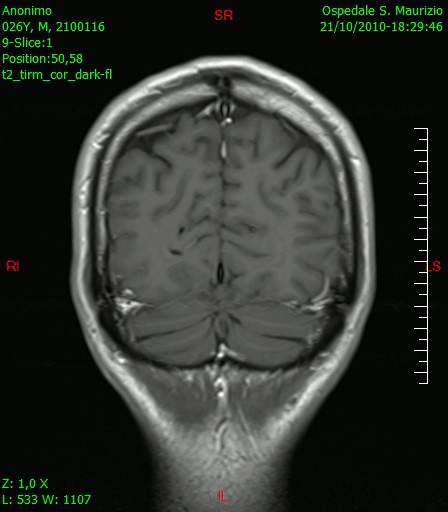

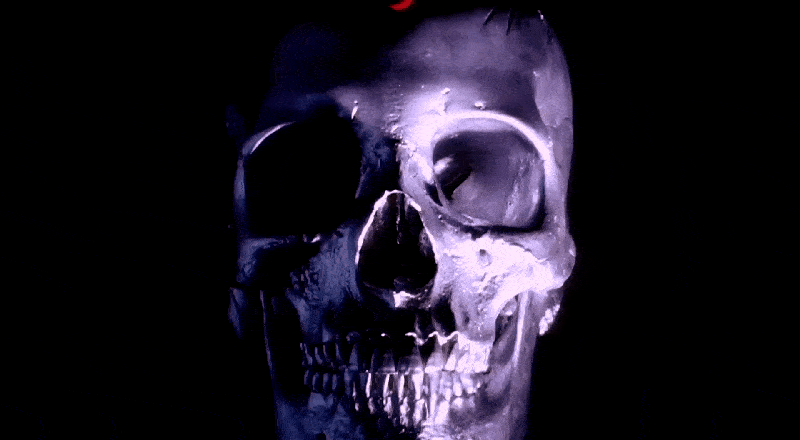





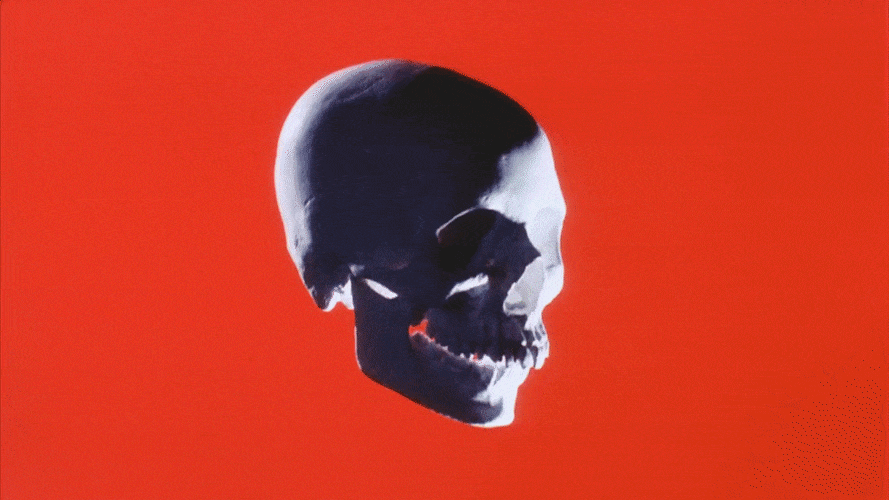
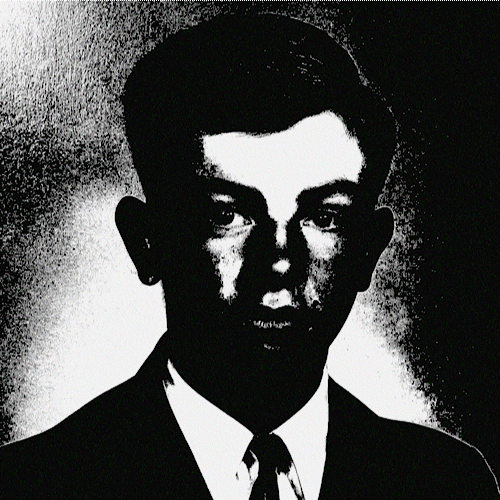
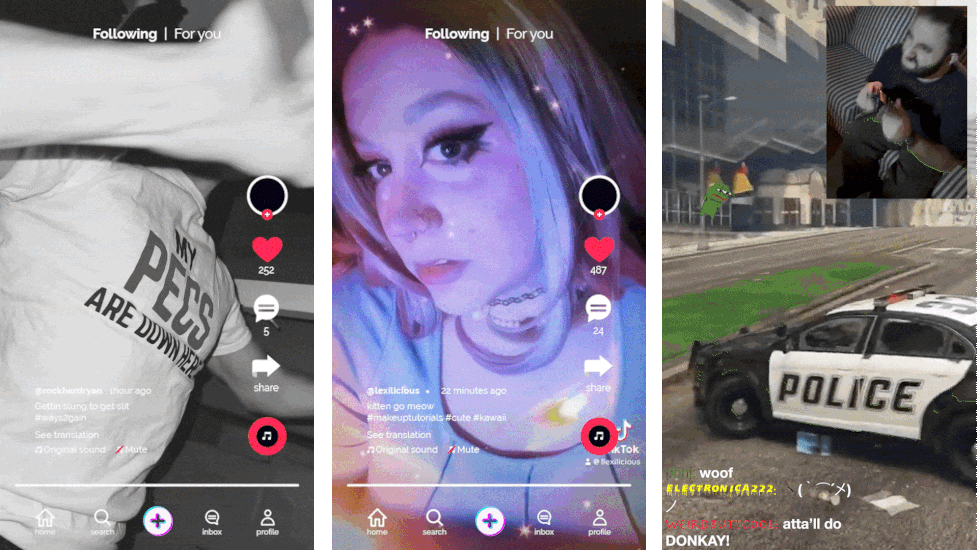


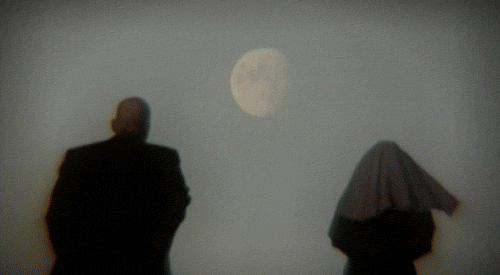
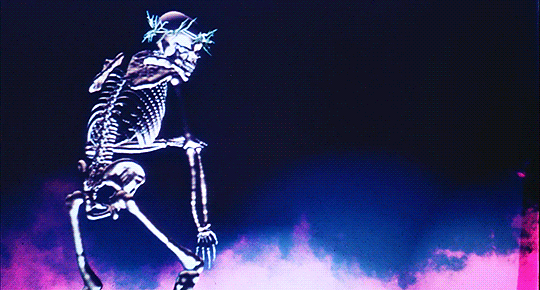

































 Now available in North America
Now available in North America 